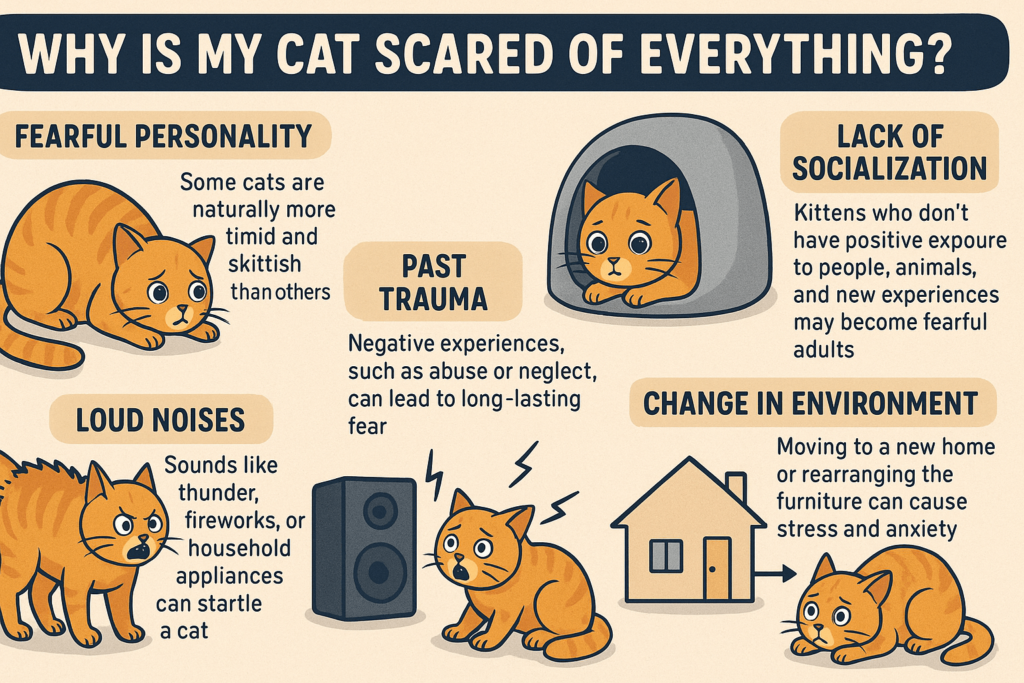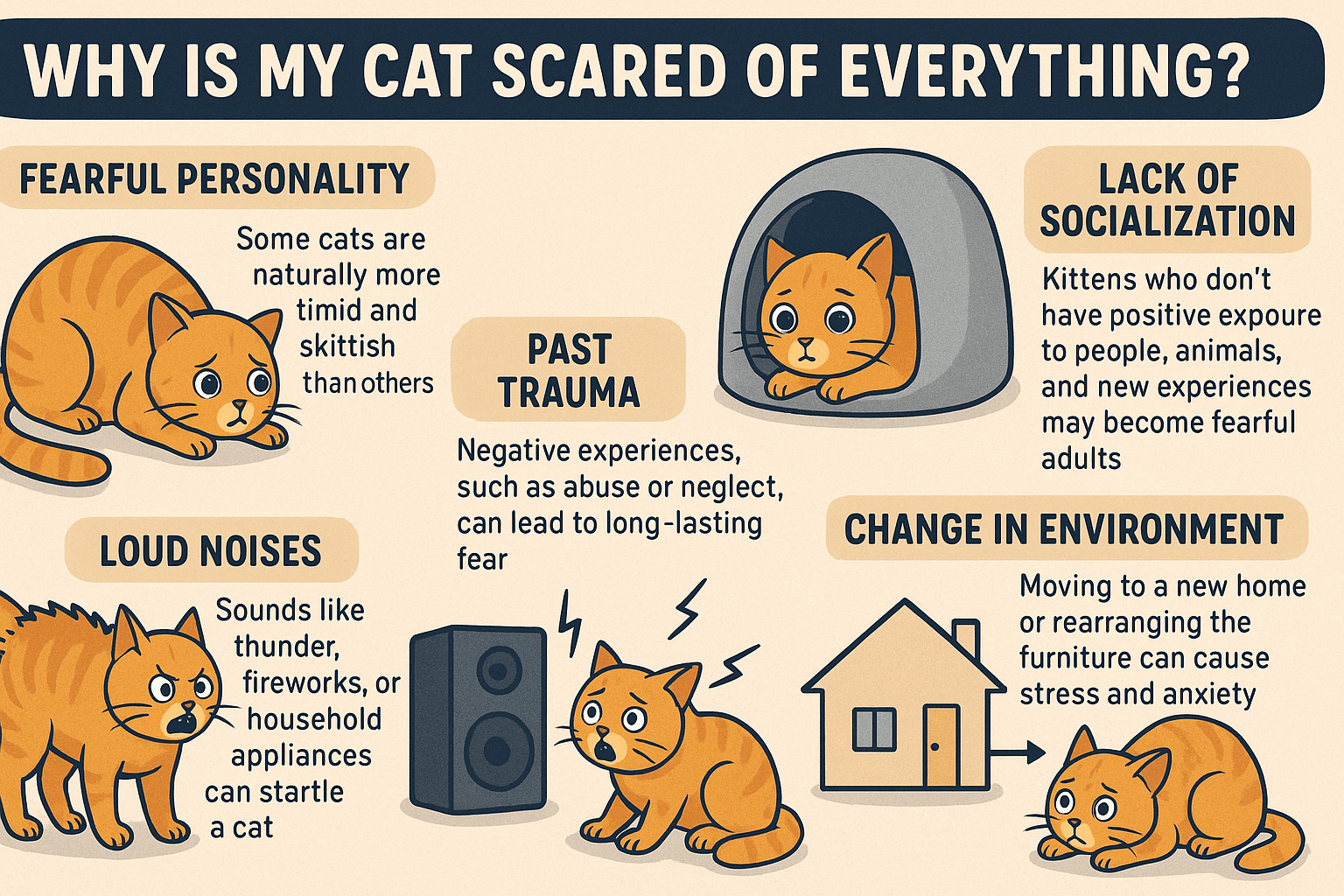Why Is My Cat Scared of Everything?
Cats are often portrayed as confident, independent creatures, but what happens when your feline friend seems perpetually on edge? If your cat is scared of everything—whether it’s loud noises, sudden movements, or unfamiliar people—it can be concerning and even heartbreaking. Fearful behavior in cats is more common than you might think, and understanding the root causes can help you provide the support and comfort they need. In this blog post, we’ll explore why your cat might be so fearful, how to identify triggers, and what steps you can take to help them feel safe and secure.
Expert Insight: The Importance of Socialization in Cats
“Cats who are well-socialized—meaning they have spent time around other cats, people, and dogs, starting from a young age—tend to be less fearful. This social and environmental exposure should be positive, with rewards for good behavior, such as a treat.”
Common Causes of Fear in Cats
Fear in cats can stem from a variety of factors, ranging from their environment to past experiences. Identifying the underlying cause is the first step toward helping your cat overcome their anxiety.
Lack of Early Socialization:
Kittens that don’t interact with people, other animals, or new environments during their critical socialization period (2-7 weeks old) may grow up to be fearful adults.Past Trauma or Abuse:
Cats adopted from shelters or rescued from neglectful situations may carry emotional scars that make them wary of their surroundings.Genetic Predisposition:
Some cats are naturally more anxious or timid due to their genetic makeup, making them more prone to fear-based behaviors.Sudden Changes in Environment:
Moving to a new home, introducing a new pet, or even rearranging furniture can overwhelm a sensitive cat and trigger fear responses.Health Issues or Pain:
Underlying medical conditions, such as arthritis or dental pain, can make a cat more reactive and fearful as they associate certain stimuli with discomfort.
By pinpointing the source of your cat’s fear, you can begin addressing their needs and creating a calmer environment for them.

Signs Your Cat Is Feeling Scared
Recognizing the signs of fear in your cat is crucial for intervening early and preventing escalation. These behaviors often indicate that your cat feels threatened or uneasy.
Hiding Behavior:
A scared cat will frequently retreat to secluded spots like under beds, behind furniture, or inside closets to avoid perceived threats.Dilated Pupils and Flattened Ears:
Wide eyes and ears pressed flat against the head are classic indicators of fear or stress in cats.Excessive Vocalization:
Hissing, growling, or yowling can signal that your cat feels cornered or threatened by something in their environment.Aggression or Defensive Postures:
A frightened cat may arch their back, puff up their fur, or swipe at perceived threats as a way to protect themselves.Refusal to Eat or Use the Litter Box:
Stress can lead to changes in appetite or litter box habits, which are often overlooked signs of fear.
Understanding these cues allows you to respond appropriately and create a sense of safety for your feline companion.
Check this guide 👉Why Is My Cat Scared of Strangers? Best 7 Behavior Tips!
Check this guide 👉How to Introduce a Scared Cat to a Dog: Best 7 Tips!
Check this guide 👉Do Cats Pee When Scared? Best 7 Expert Tips!
Triggers of Fear in Cats | Ways to Help Your Cat Feel Safe |
|---|---|
Loud noises (vacuum, thunderstorms) | Provide quiet spaces to retreat to |
Sudden movements or gestures | Move slowly and avoid startling them |
New pets or strangers in the home | Gradually introduce new people or pets |
Changes in routine or environment | Maintain consistency whenever possible |
Past traumatic experiences | Offer patience and positive reinforcement |
How to Create a Calm Environment for Your Cat
A peaceful home environment plays a vital role in helping your cat feel safe and reducing their fearfulness. Here are some strategies to create a calming space.
Designate Safe Spaces:
Set up cozy hideaways, such as covered beds or cardboard boxes, where your cat can retreat when feeling overwhelmed.Use Calming Products:
Consider using pheromone diffusers or sprays designed to soothe anxious cats and reduce stress-related behaviors.Minimize Noise Levels:
Keep household noise to a minimum by closing windows during storms or using white noise machines to block out unsettling sounds.Establish a Routine:
Cats thrive on predictability; feeding, playing, and grooming at consistent times helps build trust and reduces anxiety.Limit Unnecessary Stimulation:
Avoid overwhelming your cat with too many visitors, loud music, or chaotic activities that could heighten their fear.
By implementing these measures, you can transform your home into a sanctuary where your cat feels secure and relaxed.
Tips for Helping Your Cat Overcome Fear
While every cat is unique, there are universal techniques you can use to gradually reduce their fear and build confidence over time.
Desensitization Techniques:
Introduce scary stimuli (like vacuum cleaners) at a low intensity and reward calm behavior to help your cat adjust.Positive Reinforcement:
Reward brave actions, such as approaching a feared object, with treats, praise, or playtime to encourage progress.Interactive Play Sessions:
Engage your cat in daily play with toys that mimic prey, such as wand toys, to boost their confidence and distract from fears.Consult a Veterinarian:
Rule out medical issues contributing to fear and seek advice on behavioral modification techniques if needed.Patience and Consistency:
Building trust takes time; remain patient and consistent in your efforts to reassure your cat.
With dedication and care, you can guide your cat toward overcoming their fears and enjoying a happier life.
Common Mistakes When Dealing with a Scared Cat
Avoiding common pitfalls ensures you’re supporting your cat effectively without unintentionally worsening their fear. Here are some mistakes to steer clear of.
Forcing Interaction:
Pushing your cat to engage before they’re ready can intensify their fear and damage trust. Let them set the pace.Ignoring Signs of Stress:
Dismissing subtle signs like hiding or flattened ears can lead to bigger behavioral problems down the line.Using Punishment:
Yelling or scolding a fearful cat will only reinforce their anxiety and make them less likely to trust you.Overwhelming Them with Attention:
Bombarding a scared cat with affection can feel invasive and counterproductive. Respect their boundaries.Neglecting Veterinary Care:
Failing to address potential health issues can leave your cat in unnecessary pain, exacerbating their fear.
Avoiding these mistakes sets the stage for a supportive and healing relationship with your cat.
The Role of Enrichment in Reducing Fear
Environmental enrichment can significantly reduce fear in cats by keeping them mentally stimulated and physically engaged.
Provide Scratching Posts and Toys:
Offering outlets for natural behaviors keeps cats occupied and distracts them from stressors.Create Vertical Spaces:
Installing shelves or cat trees gives your cat elevated vantage points, boosting their sense of security.Rotate Toys Regularly:
Introducing new toys periodically prevents boredom and encourages exploration.Set Up Window Perches:
Allowing your cat to observe birds or outdoor activity satisfies their curiosity and reduces tension.Incorporate Puzzle Feeders:
Feeding via puzzle feeders taps into their hunting instincts and provides mental stimulation.
Enrichment not only entertains your cat but also builds resilience against fear.
How to Build Trust with Your Scared Cat
Building trust takes time, but small, consistent actions can make a world of difference for a fearful cat.
Speak Softly and Calmly:
Harsh tones can intimidate a scared cat. Use gentle speech to convey reassurance.Offer Treats and Meals by Hand:
Associating your presence with food helps create positive associations and fosters trust.Respect Their Boundaries:
Never force physical contact; allow your cat to initiate interactions when they feel comfortable.Use Familiar Scents:
Incorporate items that smell like you, such as blankets or clothing, into their safe spaces to provide comfort.Celebrate Small Wins:
Acknowledge incremental progress, no matter how minor, to stay motivated and encourage further improvement.
With persistence and kindness, you can earn your cat’s trust and help them overcome their fears.
Frequently Asked Questions About Fearful Cats
Why does my cat run away when I approach?
Your cat may associate your approach with something negative, such as being startled in the past. Move slowly and let them come to you.
Can I train my cat to stop being scared?
Yes, through gradual desensitization and positive reinforcement, many cats can learn to overcome their fears.
What should I do if my cat hides all day?
Respect their need for space while providing food, water, and a litter box nearby. Encourage interaction gently over time.
Is my cat’s fear normal or abnormal?
Mild fear is normal, but excessive or prolonged fear may indicate an underlying issue requiring professional attention.
Should I punish my cat for fearful behavior?
No, punishment will only increase their anxiety. Focus on rewarding calm and confident behavior instead.
Supporting Your Fearful Feline Friend
Living with a scared cat can be challenging, but it’s also an opportunity to deepen your bond and provide the love and reassurance they need. By understanding the causes of their fear, recognizing the signs, and taking proactive steps to create a safe environment, you can help your cat feel more secure and confident. Remember, patience and empathy are key—your compassionate efforts will go a long way in helping your feline friend thrive. With time and care, even the most fearful cats can learn to trust and enjoy life to the fullest.
Understanding Cryptosporidium in Cats: Best 7 Expert Tips! – Spot symptoms, treat safely, and stop parasite spread in your home.
Understanding Cryptosporidium in Dogs: Best 7 Expert Tips! – Learn symptoms, treatment & prevention for this stubborn gut parasite.
Understanding Syringomyelia in Cats: Best 7 Expert Tips! – Recognize signs, manage pain, and support your cat’s neurological health with vet-backed guidance.
Understanding Syringomyelia in Dogs: Best 7 Expert Tips! – Expert insights on symptoms, MRI diagnosis, pain management & quality of life.





